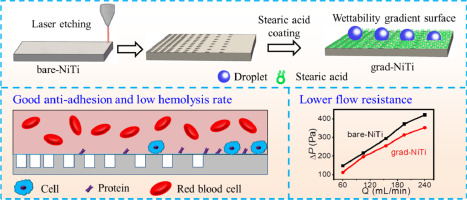Biomaterials Advances ( IF 5.5 ) Pub Date : 2020-03-13 , DOI: 10.1016/j.msec.2020.110847 Quanchao Zhang , Jiaojiao Dong , Mengxia Peng , Zhiwei Yang , Yizao Wan , Fanglian Yao , Jianye Zhou , Chenxi Ouyang , Xiaoyan Deng , Honglin Luo

|
Blood contacting materials with anti-thrombotic surfaces are highly demanded in clinics. Despite considerable research on surface modifications, limited progress has been made on effective prevention of thrombosis for artificial implants such as mechanical valve prosthesis. Herein, wettability gradient surface, which can ideally exhibit good hemocompatibility and low flow resistance, was developed for potential reduction of thrombosis. The wettability gradient surface on a model substrate of nickel-titanium (NiTi) alloy was prepared via a simple and economic method that combined laser microfabrication and surface stearic acid self-assembly approach. Scanning electron microscopy (SEM) observation confirmed that the wettability gradient surface was composed of a smooth NiTi region and three porous regions with different pore sizes and distances. Contact angle measurement revealed that, together with a low surface energy layer, the structural topography gradient could create a wettability gradient surface on NiTi alloy which could drive droplet motion. When compared with bare NiTi, such wettability gradient surface exhibited better anti-adhesion property, which was beneficial to the hemocompatibility and thus showing a lower hemolysis rate. Additionally, the wettability gradient surface also showed much lower flow resistance than bare NiTi. These results demonstrate that the developed wettability gradient surface may be used to reduce thrombosis.
中文翻译:

NiTi合金上的激光诱导的润湿性梯度表面可改善血液相容性和流动阻力
在临床上对具有抗血栓形成表面的血液接触材料有很高的要求。尽管在表面改性方面进行了大量研究,但是在有效预防诸如机械瓣膜假体的人工植入物的血栓形成方面进展有限。在此,开发了理想地表现出良好的血液相容性和低流动阻力的润湿性梯度表面,以潜在地减少血栓形成。通过将激光微加工和表面硬脂酸自组装方法相结合的一种简单而经济的方法,在镍钛(NiTi)合金模型基板上制备了润湿梯度表面。扫描电子显微镜(SEM)观察证实,润湿性梯度表面由光滑的NiTi区和三个具有不同孔径和距离的多孔区组成。接触角测量表明,与低表面能层一起,结构形貌梯度可以在NiTi合金上形成可润湿性梯度表面,从而驱动液滴运动。当与裸露的NiTi相比时,这样的润湿性梯度表面表现出更好的抗粘附性,这有利于血液相容性并因此显示出较低的溶血速率。另外,可湿性梯度表面还显示出比裸露的镍钛合金低得多的流动阻力。这些结果表明,开发的润湿性梯度表面可用于减少血栓形成。这样的润湿性梯度表面表现出更好的抗粘附性能,这对血液相容性是有益的,因此显示出较低的溶血速率。另外,可湿性梯度表面还显示出比裸露的镍钛合金低得多的流动阻力。这些结果表明,开发的润湿性梯度表面可用于减少血栓形成。这样的润湿性梯度表面表现出更好的抗粘附性能,这对血液相容性是有益的,因此显示出较低的溶血速率。另外,可湿性梯度表面还显示出比裸露的镍钛合金低得多的流动阻力。这些结果表明,开发的润湿性梯度表面可用于减少血栓形成。











































 京公网安备 11010802027423号
京公网安备 11010802027423号